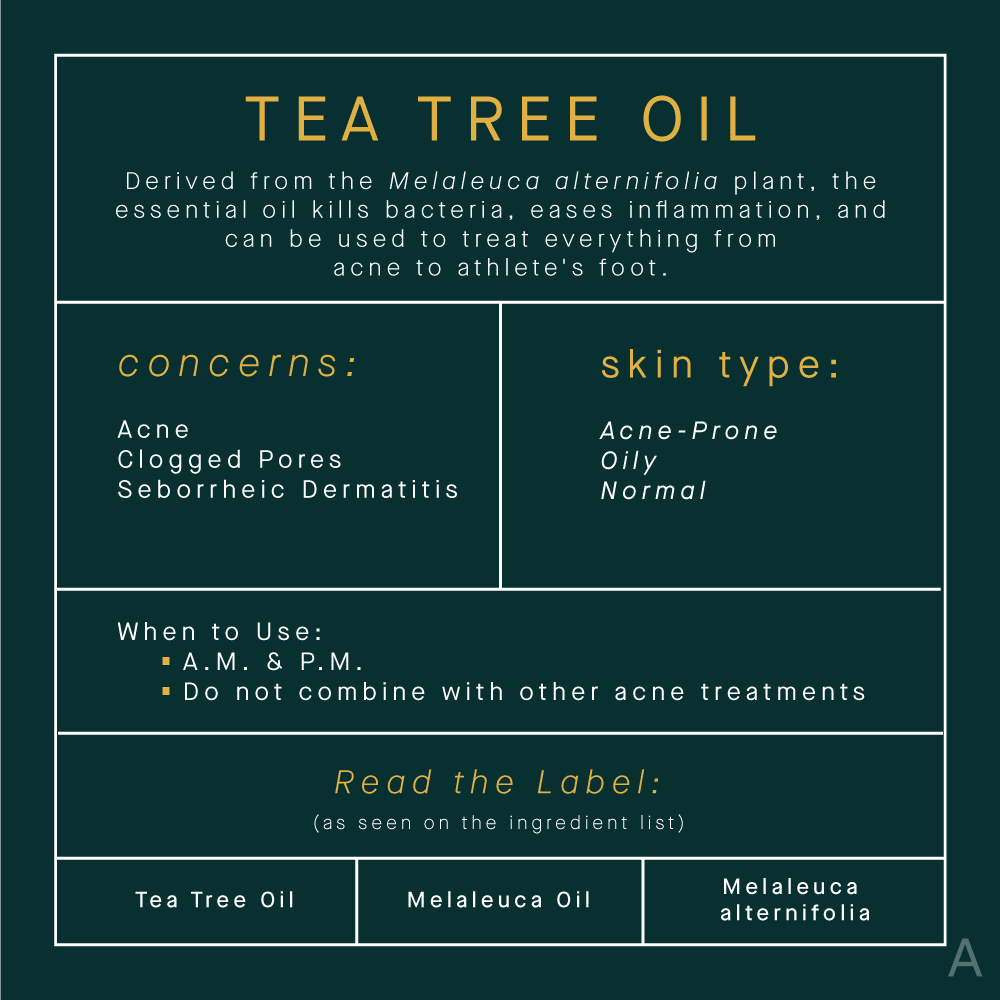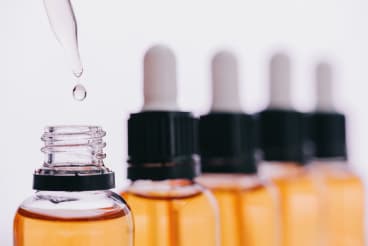 Salicylic Acid Peel
Salicylic Acid PeelRead The Label: All Your Tea Tree Oil Questions Answered
Tea tree oil is a powerful antimicrobial ingredient that soothes and clarifies. Here’s what the experts have to say to anyone who wants to add the extract to their skincare routine.
Feel like you need a dictionary every time you look at the ingredient list of a beauty product? Still unsure of the difference between retinol and retinoids? What about the unique benefits of vitamins B, C, and E? Are alpha and beta hydroxy acids the same thing? The skincare aisle can be overwhelming, but you don’t need a PhD in cosmetic chemistry to navigate it. With expert help, The AEDITION is demystifying and simplifying the beauty industry — one label at a time.
Tea tree oil, also known as melaleuca oil, is an ingredient that seems to appear just about everywhere these days — from skincare, hair care, and foot care to bath time — but do you know the extent of its benefits? The all-natural (and vegan!) ingredient plays well with other actives and can be used morning and night to treat a host of concerns. Intrigued? The AEDITION breaks down everything you need to know about adding tea tree oil to your routine.
What Is Tea Tree Oil?
Tea tree oil is derived from the leaves of the tea tree, Melaleuca alternifolia, that is found in Australia and New Zealand — but don’t get this tree confused with the plants that produce the tea we drink, as they’re completely different. Indigenous Australians have been using tea tree leaves and oils to treat a myriad of ailments, including colds, wounds, and skin woes, for centuries. In fact, they would often bathe in “healing lakes that were filled with fallen tea tree leaves” to take advantage of its medicinal properties, says Krupa Koestline, a clean cosmetic chemist and founder of KKT Consultants.
In the 1920s, international interest in the tea tree grew when Australian chemist Arthur Penfold reported on the medicinal and healing properties. Commercial plantations were established in the 1970s and 1980s, leading to the industry that we know today.
The Topical Benefits of Tea Tree Oil

Tea tree oil is a workhorse that can be used on the skin, scalp, feet, and even in your baths. “Tea tree oil is used for everything from caring for the appearance of blemishes to clearing up demodex mites, which have been correlated with rosacea and other skin imbalances,” explains Chase Polan, founder and lead alchemist of Kypris. “Tea tree oil can also be used for athlete’s foot, dandruff, and a whole host of other pesky microbes that trouble the appearance of skin.”
If you are dealing with maskne and breakouts, your clarifying products may very well contain tea tree oil. As New York City-based board certified dermatologist Angela Lamb, MD, explains, the ingredient is considered to be an anti-inflammatory, which is why it’s a great choice for treating acne and bug bites. And then there is the aromatherapy component. “Aromatherapeutically, tea tree oil can be used to create an environment of calm refreshment,” Polan notes. “Many spas diffuse tea tree oil.”
The Best Candidates for Tea Tree Oil
People with oily and/or acne-prone skin will see the most benefit from adding tea tree oil to their routine, as it can:
- Clear and prevent breakouts
- Reduce skin congestion
- Soothe irritated skin
While the ingredient is generally safe to use on most skin types and skin tones, there is a chance for irritation — especially for those that have a history of allergic reactions or sensitive skin. If you’re unsure about how your skin will react to tea tree oil or a product that contains the ingredient, patch test it on your wrist overnight before applying it to a larger treatment area.
Finding the Right Tea Tree Oil Product
Tea tree oil is often sold in its pure, natural form (like this pick from The Body Shop). “Tea tree oil is one of the few essential oils that can be applied neat, meaning undiluted,” Polan explains. To ensure it behaves as intended and does not cause undue irritation, pay attention to how it’s packaged and stored. “It’s really important that the essential oil not be oxidized by age or heat or exposure to light or poor storage,” she adds. For undiluted use, Koestline suggests applying a drop of tea tree oil onto a damp cotton bud and carefully dotting the acne lesion or spot that you’re trying to clear.
Pure tea tree oil may be too strong for some people, which is why the aforementioned patch test is important. You can also dilute your essential oil with a carrier oil (think: jojoba, sweet almond, olive, avocado) before applying it. Renée Rouleau, celebrity aesthetician and founder of her eponymous skincare line, recommends looking for a tea tree oil that is “cold-pressed or CO2 extracted” because it will be “gentler.”
When it comes to products that contain tea tree oil, the sky's the limit! The ingredient can be found in masks, moisturizers, and serums, and it really just depends on your needs, wants, and routine. The Kypris Clearing Serum is ideal for soothing problem skin, while the Renée Rouleau Rapid Response Detox Masque reduces the microbial count on your skin’s surface to interrupt breakout cycles. On the cleansing and toning front, Biossance Squalane + Tea Tree Cleansing Gel is a gentle option for acne-prone skin, while the Carbon Theory Acid Breakout Control Facial Purifying Tonic combines tea tree oil and citric acid to clarify.
How to Add Tea Tree Oil Into Your Skincare Routine
Tea tree oil can be used A.M. and P.M., and it generally plays well with other products and ingredients. With that said, Rouleau and Polan both noted that they would not mix tea tree oil with retinoids due to the possibility of additional irritation. Rouleau also suggests refraining from pairing tea tree oil with fellow acne-fighter benzoyl peroxide.
You should always be wearing sunscreen during daylight hours, but, depending on the type of tea tree oil you are using, you may need to be extra diligent. “When used at 1 percent within a product formula (which is usually the amount used), it should not create skin sensitivity,” Rouleau shares. “But, when used in high amounts and in its pure form, tea tree oil can increase photosensitivity.” In such cases, she recommends treating it “like any other acne treatment” and using a sunscreen daily (we’re big fans of her Weightless Protection SPF 30).
When it comes to using tea tree oil post-procedure, Polan suggests taking a break if you’ve just had any kind of chemical peel or abrasion, as there is a chance for irritation. “I wouldn’t recommend tea tree after an intense exfoliation or any kind of peeling or ablative treatments until the skin is completely healed,” she says.
One last important thing to note: Although tea tree oil is a natural ingredient, it should not be ingested. If swallowed, symptoms may include, drowsiness, confusion, and loss of consciousness, and you should immediately see a doctor.
The Takeaway
Tea tree oil is a naturally occurring ingredient that has gained popularity for its anti-inflammatory and antibacterial properties, and people with acne or oily skin will benefit most from the potent active. While it can be applied in its pure form, it’s simplest to use as part of a cleanser, serum, or mask. Be sure to consult with your dermatolgoist or aesthetician to determine if tea tree is right for you.
All products featured are independently selected by our editors, however, AEDIT may receive a commission on items purchased through our links.
More Related Articles
Related Procedures

AI Plastic Surgeon™
powered by'Try on' aesthetic procedures and instantly visualize possible results with The AI Plastic Surgeon, our patented 3D aesthetic simulator.

